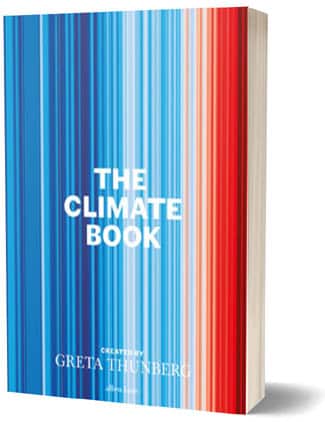

Greta Thunberg
THE CLIMATE BOOK
The Facts and the Solutions
PenguinRandomHouse, 2023
reviewed by Jeremy Williams
The last book with Greta Thunberg’s name on it was a slim volume of speeches that you could read in an hour. She’s a good writer and I’ve been looking forward to something more substantial. Well, this would be it: a 446 page tome with the boldly definitive title The Climate Book.
Thunberg’s message has always been to listen to the science, and this is something she’s put into practice here. “I have decided to use my platform to create a book based on the current best available science – a book that covers the climate, ecological and sustainability crisis holistically,” Thunberg writes. “My hope is that this book might be some kind of go-to source for understanding these different, closely interconnected crises.”
Thunberg plays an editorial role here and directs our attention to scientists, activists, economists and others across a series of short chapters in a straightforward structure:
- How climate works
- How our planet is changing
- How it affects us
- What we’ve done about it
- What we must do now
There are 100 or so essays across those five parts, and it’s a proper who’s who of the climate world. Science comes from Johann Rockstromm on tipping points, Zeke Hausfather on methane emissions, Friederike Otto on weather. Michael Mann. Katherine Hayhoe. You want an economics perspective? Here’s Nicholas Stern, Thomas Picketty or Kate Raworth. Some cultural reflection? How about Margaret Atwood and Amitav Ghosh? There are activist takes from Naomi Klein, Erica Chenoweth, George Monbiot. And as always, Thunberg has eye on justice and the global impacts of climate change, so Hindou Oumarou Imbrahim writes from the Sahel, Sunita Narain from India, Sonia Guajajara from the Amazon, and Elin Anna Labba reports from Sweden’s own Sami indigenous people.
Among the 100+ contributors, Thunberg’s own voice provides a through-line of commentary. Her essays introduce sections and link things up, with all of her usual urgency, moral clarity, and take-no-prisoners dismissal of anyone who thinks the world is doing enough.
The book is a lot, it’s fair to say. It’s been on my shelf and on the coffee table since December. It’s partly taken a while to read because it’s too hefty to take it with me and read on the go. This is a hardback book the size of a dictionary or a textbook, which is fair enough for what it’s trying to do.
It’s also a slow read because there’s just so much information. Global experts in their subject get three or four pages to distill a life’s work, and then you turn the page and it’s someone else’s turn. Reading the book in one go is probably not going to get the best out of it. But if you were to read two or three essays a day for two months, you’d have a really solid understanding of where we are and how it all works. You’d understand the science, the consequences of inaction, the impacts and the injustices, and what we might be able to do about it all.
If you want one climate book to summarize them all, this is it. Let’s get it in every school library in the land.
Reposted, with permission, from Jeremy Williams’ blog The Earthbound Report.



There’s no marxist ecologist included, and there no call thats capitalism is the devil behind ecological crisis! Then for me, well its not enough